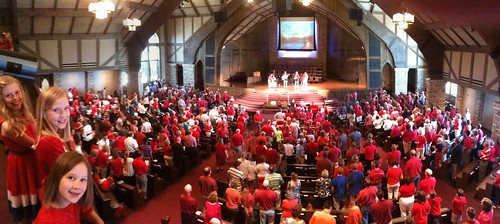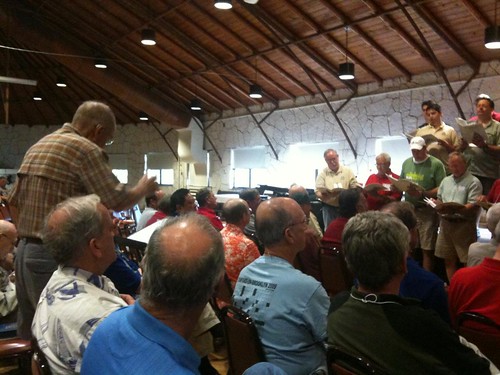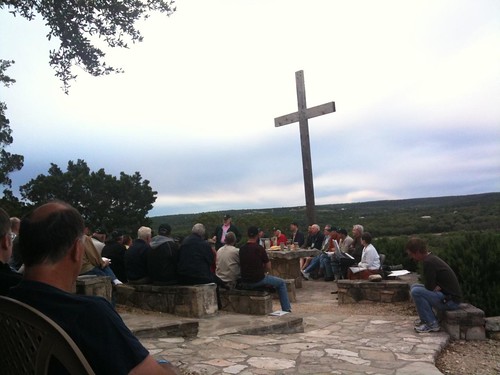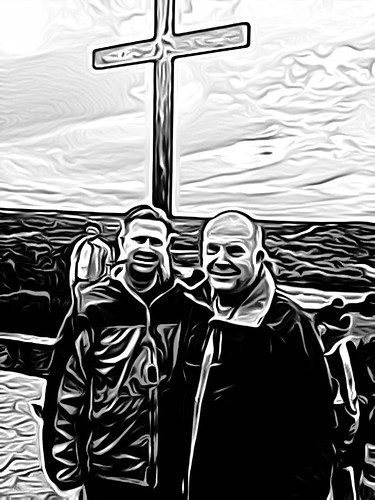These are my notes from a meeting on 6-16-2007 at First Presbyterian Church in Edmond, Oklahoma about “Missional Church” and reviewing a recent congregation survey about our church’s readiness to become a more missionally oriented church. (MY OWN THOUGHTS ARE INCLUDED IN ALL CAPS.) I originally posted this on a WordPress.com blog which I have since not visited or used, and am deleting– so I’m cross-posting this to both share it and create my own digital archive of these notes.
After today, listening groups will be formed which will meet once per month for the next four months. These will be discussion groups to focus on the issues we’re outlining today.
What is missional church? 2 summers ago we developed a vision statement for our church, and out of that came our focus on missional church. Our mission statement:
“The First Presbyterian Church of Edmond (PCUSA) is a vibrant Christ-centered church whose people are called by God to seek and do His will. We reach up to God in joyful reverence and awe in worship. We reach out to neighbors near and far with a witness of His salvation and message of hope. We reach in to teach and encourage each other, to know and apply God’s Word and to utilize our spiritual gifts in His service.”
We are committed, through our vision, to “assume a missional identity”
– We will cultivate an environment in which missional imagination emerges. We begin the process of becoming a missional church that discerns, celebrates, and participates in God’s redemptive mission in the world.
There are LOTS of different ideas about what missional church means
– lots of different perspectives
– it is a new paradigm, not just a “tweak”
– it is a philosophy
– a way of understanding church
– hopefully it will be a movement
Missional church is NOT:
– simply more mission
– an evangelism program
– a new way of doing foreign missions
– a method for church growth
– the “next” way to do church
– a post-modern way of doing church
– an anti-traditional pattern of church
an “emergent church” often tries to throw out everything traditional, and do something different
– that is NOT missional church
Came from the writings of Bishop Lesslie Newbigin, the experience of Western Europe
– same trends in North America
– The Gospel and Our Culture Network (GOCN, www.gocn.org)
— the idea of reintroducing the gospel into our culture in North America
– “Missional Church: A Vision for the Sending of the Church in North America” by Guder et. al. (1st project of the GOCN)
DEFINITION of missional church
– there is no simple, straightforward definition
– it is NOT all confusion either, however
– there are themes we can develop to get a picture of what it is
Overarching Themes
– Western Society as a Mission Field
— seeing the world as God’s mission field, of which we are a part
– Mission as the Missio Dei (Mission of God)
– The Church as a Contrast Society
— in Christendom, the church WAS the center of the culture
— not true today
Our Community as a Mission Field
– Christianity is almost dead in Western Europe
– In Canada emerging generations no longer know the Christian narrative
– the US is not far behind
– “the facade of suburban mega-churches” can give us the false impression that all is well with the churches in North America
– We must fundamentally rethink the “come and see church” and become missionaries to our culture
– requires more than adjustment
– calls for a new kind of church
The Mission of God
– in Western churches for centuries, the church focus has been on HOW God serves and meets our needs
– in the early church the focus was more on WHAT GOD HAD DONE in the life, death and resurrection of Jesus
– we need a GOD-CENTERED understanding of Jesus’ life, death, and resurrection
– we need to focus on what God is doing, and wants to do in the world
– we need to discern how we are called to be part of that mission
– we are not the ENDS of God’s mission, we are the instruments
Ecclesia, in Greek it means “called out”
– used in a political sense in Greek society
– the Church is an ecclesia: called to public life as sign, witness and foretaste of where God is inviting all creation in Jesus Christ
– the church is not just a synogogue (a gathering)
– Church is formed around beliefs and practices which demonstrate a way of life which cannot be derived from the culture in which it is found
The Kingdom of God is inviting all of creation to come in
– the way of life modeled by the church STANDS IN CONTRAST to the ways people are living in the culture
– it can’t be derived from the predominant culture
How do we get there?
– church must return to its sources
– not by copying or reverting to some past
– by discerning the shape of a faithful presetn and future
– this will be context specific
– not a strategy adapted to our setting
– by being the church of our setting
What you are going to become like is very specific for your context
– something that is working in California will not be able to just overlay on us and be successful
– so we need to disern
Dialog: conversation between two people
– Newbigin suggests a Three Way Conversation: between the Church, the Gospel, and the Culture
– the person leading John’s doctoral program has criticized the GOCN as not including the interaction with the CULTURE enough
– Roxburgh proposes a 3 way conversation between the Contrast Society, Missio Dei (God’s mission to the world) and the Missionary Context
The Bible is a missionary text from start to finish
– Isa 58:6-10
– this is missional language
– a vision of the people of Israel being the light on the hill
The Reality
– Matt 5:14-16
– Jesus envisioned his messiahship in close terms to the vision of Isaiah
– “You are the light of the world. A city on a hill cannot be hidden. Neither do people light a lamp and put it under a bowl. Instead they put it on its stand, and it gives light to everyone in the house. In the same way, let your light shine before men, that they may see your good deeds and praise your Father in Heaven.”
Also, Eph 2:8-10
– image of light emerges again
– “For you were once darkness, but now you are light in the Lord. Live as children of light (for the light consists in all goodness, righteousness
Part of the way we respond as a missional church is identifying needs that are unmet in a local or global community, we act to meet those needs
– foster care, literacy, homelessness, etc
– being a sign, a witness, and a foretaste
This survey is focused on asking how do we do things, and are we doing it in a way that promotes missional thought and understanding
we are not attempting to be a social agency by any means
– but we are attempting to be a witness to the kingdom of God
– they ways in which we discern needs and seek to meet them should differentiate us from secular world
Example is the OK governor’s marriage initiative (Oklahoma Marriage Initiative) and the work of churches on this issue
– we also can and need to be an example for the other CHURCHES in our community
– many of the other churches in our area are NOT doing these types of things
– we are doing some of these already, and that is good
– there is a strong need for CHURCH LEADERSHIP
– re-conceiving the idea of the life of our church around this idea
Is an idea of the CHURCH itself being a missional field part of this? YES.
– Daryl Guder’s follow-up book focuses on this, the continuing need to reconvert the members of our own churches
– “The Essence of the Church” was another followup book by someone else
So what is going on here at FPC Edmond?
The Genesis
– The Vision statement of our church, formulated through a process started 2 years ago
– have had some reorganization, rethinking the ways we as staff function in the church
– John came up with a position statement of “Missional Leader”
— that means the intent of John’s role is to provide leadership of areas that will move people to a more missional understanding of church
— problem with reading the literature is you really get on fire for doing this, but no one is really sure how to do this
Missional Leadership cohort at Fuller Theological Seminary is Alan Roxburgh
– he is going all over the place trying to move things along
– works primarily at an adjudicatory level (at a presbytery level often)
– is trying to initiate a process of conversation within the contexts in which people are working
Missionaal Leadership Cohort claims
– “our culture is experiencing rapid tumultuous change that is affecting the very structure and significance of church leaders.”
– “As leaders, we are at the center of this transition, facing the challenge of how to re-vision church leadershipo to meet the uncharted requirements of being a faithful church in a postmodern world.”
– “Church leadership needs Spirit-empowered, missional leadership that has a dynamic impact on the church as well as their local communities.”
– “Through the Missional Leadershp Cohort we are equipped to engage our culture with broadened perspectives and practices grounded in the Biblical narratives.”
Favorite phrase of Alan: “Rapid discontinuous change”
different leadership is needed that is very adaptable to changing contexts
– spiritual lead leadership is very important
The first year the focus is primarily on the person enrolled in this program
– focus on leadership and the CONTEXT we are in (lots of reading on the cultural context)
– goals: develop missional leaders, use a missional leadership assessment process, learn about change, transition, systems and leadership, also the theological basis for missional leadership
In this program, if you change churches, you have to start over
Year Two: focuses on ecclesiology (the church) and works with processes for forming missional leaders
– forming missional systems
– assessing church readiness for missional change
– research methods for studying missional congregations
– missional ecclesiology in the North American context
Year Three: focuses on missiology with attention to developing the frameworks and skills for cultivating missional change in our actual ministry context
– engaging missional contexts
– assessing primary themes and issues with organizational systems related to innovative transformation
– constructing local theologies (that does not mean reinventing the gospel, it means that we are Presbyterian, PCUSA, suburban, fairly homogenous, etc… what do those things mean for us in our missional focus, not changing our doctrinal theology but HOW DO WE LIVE our theology in our context?)
Year Four: Creating a missional church action plan
the Challenge
– Heifets (sp?) at Harvard Business schools identifies 3 types of challenges
– Type 1 Challenge: readily identified problem with a technical solution
– Type 2 challenge: complex situations that can be broken down into multiple type 1 challenges with technical solutions
– Type 3 challenge: there are no technical solutions available. Addressing the challenge requires changes in core values and understanding. This requires “adaptive work”
– the thing that characterizes “adaptive work” is you DON’T WANT TO DO IT (people deflect, resist– this requires a different type of leadership)
The journey we are on is a type 3 challenge
– it requires us to RETHINK WHO WE ARE
– coming out at the end can be very rewarding
The Missional Change Model (Figure 5.3 from one of Roxburgh’s books)
– awareness
– understanding
– evaluate
– experiment
– commitment
Awareness is about getting the language out there
Understanding involves synthesis of these ideas
Evaluation: we get a handle on the concepts, but start to look at where we are in the process
Commitment is where you buy in
we are NOW actually in all these places, because this is not a uniformly linear process
– iterative process
Stage 1: Creating awareness
– through intensive communication events, both one-on-one and in groups, leaders tak people through dialog and discussion about the need for missional transformation of the church.
– getting the word out
– diffusing
Stage 2: Creating understanding
– dialog serves to bring thinking and feeling modes of understanding together into a coherent pattern of understanding
Stage 3: Evaluation
– congregation is evaluated in light of awareness and understanding
Stage 4: Creating experiments
– people are now starting to think experimentally
– people identify actions they believe will move them towards becoming a missional church
– critical word is ACTION, people experiment through action
Stage 5: Commitment
– people commit to getting others involved in the process of moving through awareness to understanding, to evaluation, to experimentation, and finally to commitment
Everett Rogers book in the 70’s: “The Diffusion of Innovation” (looks at farming and medical innovations)
– process begins with the 10-15% of congregation that are innovators
– timeline looks like: 1st 18 months, 10% through the MC model
– 2nd 18 months: these folks lead next 15% through
– By the end of 3 years, there is 25% commitment
– 3rd 18 months, 50-65% of remaining led through
– unfortunately 10-25% fight and resist, some will leave
For us, 10% of our regular worshippers is about 80, while 10% of our entire congregation would be 180
As we get people who are committed to the model
– Rogers says whenever 25% of a poplution buys in, then the process takes off
– I’M THINKING THIS IS ANALOGOUS TO THE “TIPPING POINT”
In traditional church, staff are professionals who provide goods and services to the members of the congregation
– in the missional church, people do not come to have their needs met, they come to be SENT
Foundational Assumptions
– God has instilled his missional imagination in the hearts of his people
– since God always works through the least, the last, and the unlikely, God is prepared to work through typical North American congregations
– Congregations are still at the heart of God’s purposes and can become centers of missional life
– missional leadership is the cultivation of the missional imagination of the people of God from among the people as new forms of social relationship and new forms of engagement with the context
– missional leaders cultivate communities of discourse around practices of Christian life from which emerge missional imagination and actions
God always works with the least, the last, and the unlikely!
– the point is YOU (as a human) cannot bring about the transformation of a congregation into a missional church, but GOD CAN!
Missional leadership is helping to cultivate this process
– communities of discourse
I LIKE THAT TERM “COMMUNITIES OF DISCOURSE”
I ALSO LIKE THE IDEA OF SERVING AS A CATALYST FOR CONVERSATIONS
– THIS WAS MENTIONED YESTERDAY AT MEN’S GROUP, IN THE CONTEXT OF SUFFERING OFTEN SERVING AS A CATALYST OF CONVERSATION WITH GOD
Foundational Assumptions (con’t)
– bottom up
– an effective methodology for initiating and sustaining missional innovation requires a process that begins from where people are currently located and connects them again into the memory of the narrative and tradition of the story. It is a bottom up process that begins where the people of God, themselves, are located”
Notes on our Congregational survey and results (Missional Church Readiness Survey)
The survey
– Alan showed a snapshot of his kids, and talked about how a snapshot provides a look at ourselves at the present
– provides an opportunity to engage in conversation around that
– not a magical program or imported strategic plan
– will help us have an informed awareness of the church’s readiness for the transitions required for missional transformation
Missional Church Readiness Survey
– intended to identify key missional challenges
– initiates an 8-12 month process
– not a program that fits all churches into the same mold
– allows us to discover our own forms of mission in our particular context
– requires listening to one another
Congregational Function Patterns
– four different patterns
– may display characteristics of each pattern across the various aspects of its life
– indicates self-understanding of the congregation
– patterns of recognizing and reacting to changes in context
Survey had 4 different questions followed by open responses
– each questions addressed the different patterns (no accident there were four questions of each)
– for this reason, it is rare to see “strongly agree
Response patterns:
1- Reactive
– the “circle the wagons” approach
– focused on maintaining the status quo
– church “turns in” and protects itself
– reacts to external changes and challenges
– ME: THIS IS THE “STATIST” PERSPECTIVE ARTICULATED BY VIRGINIA POSTREL IN HER BOOK “THE FUTURE AND ITS ENEMIES”
2- Developmental
– “Field of Dreams”
– assumes that what we do will attract other people, and that works, but what we typically do is attract people from other churches
– a desire to reach out to new realities of the context
– seek to do this by improving what they are already doing
– assume this will attract people to the church
3- Transitional
– realize that the emerging generations often don’t come to church anymore
– the church realizes we have to go OUT to attract others
– “Head ’em up, move ’em out”
– work on experiments
– in transition toward a new understanding of the church
4- Transformational
– “on the trail”
– after a long period of transitional learning and discovery the congregation becomes committed to a different set of values and a different self-understanding
– committed to a new way of life focused on engaging their changing contexts and the people in their communities in order to communicate the good news
The Future
– desire to develop a new future
– not by developing a strategic plan (this assumes that it is possible to know what the future will look like)
– the future is something we discover together on this journey
– the future emerges from among God’s people
John’s Dad put together the 5 year plan for Phillips Petroleum, but the company always ran on a one year plan
– he found the process to be an unfulfilling task
– the future cannot be predicted with certainty
– the future emerges from among God’s people in this view
THIS CLOSELY PARALLELS WHAT VIRGINIA POSTREL IDENTIFIES AS A “DYNAMICAL VIEW” IN HER BOOK “THE FUTURE AND ITS ENEMIES”
The four readiness factors of the survey
1- church processes
2- church focus
3- congregation
4- community context
Each have subfactors
church process factors
– leadership
– planning
– structure
– staff
church focus factors
– financial
– organizational
– communication
– programs
congregation factors
– practices
– ministry
– involvement
– energy
community context factors
– integration
– connection
– impact
– growth
We are generally blind to our own systems unless someone forces us to look at them
– if you have a train, the tracks determine where it goes
– if you want to change the direction of a train, you have to change the tracks it’s on
Our congregation in the global view is mostly in the transitional and tranformational view
– more thinking in those modes, not necessarily ACTING according to those views yet
I AM WONDERING WHY THE CHURCH DID THIS AS A VOLUNTARY SURVEY OPEN TO EVERYONE, INSTEAD OF A RANDOM SAMPLE WHICH WOULD LEND ITSELF TO BE MORE REPRESENTATIVE OF THE CHURCH POPULATION AS A WHOLE
– CONCLUSIONS ARE BEING SHARED WITH THE ASSUMPTION THAT THESE SURVEY RESULTS ARE REPRESENTATIVE OF THE CHURCH MEMBERSHIP’S IDEAS AS A WHOLE, BUT ACTUALLY THESE ARE JUST REPRESENTATIVE OF THE DEMOGRAPHIC WHICH VOLUNTARILY RESPONDED TO THIS SURVEY
– I WOULD GUESS THERE ARE MANY MORE PEOPLE IN OUR CHURCH IN THE REACTIVE AND DEVELOPMENTAL VIEWS, BUT THOSE PEOPLE ARE LESS LIKELY TO RESPOND TO A SURVEY LIKE THIS WHICH IS ORIENTED MORE TOWARDS THINKING LIKE THE TRANSITIONAL AND TRANSFORMATIONAL VIEWS
– SO I SUSPECT THESE RESULTS ARE SHARPLY SKEWED (THIS IS MY ATTEMPT TO LOOK AT THIS AN ANALYZE IT WITH SOME PERSPECTIVE FROM QUANTITATIVE STATISTICS)
Church leadership
– thought is the church Session mirrors the ethos of the congregation
– measured the spectrum from inward directed and maintaining tradition to outward directed and engaging the context
Ministers and staff
– does the system have staff primarily taking care of the members or engaging them in ministry and mission?
Structure
– structure precedes organization
– structures control the behavior of the congregation
– not an external second thought, but an internal system
ANSWER TO MY QUESTION: WHY DID WE NOT SURVEY A RANDOM SAMPLE OF THE CONGREGATION, JOHN RESPONDED THAT THE SURVEY WAS TRYING TO FOCUS ON THE 10% OF INNOVATORS IN THE CONGREGATION
– THE PROBLEM I SEE WITH THIS IS THAT AS WE ARE LOOKING AT RESULTS, SOME PEOPLE SEEM TO BE TRYING TO USE THESE SAMPLE RESULTS AND GENERALIZE TO THE OVERALL POPULATION OF THE CONGREGATION
– MY POINT WAS THAT WE NEED TO REMEMBER THESE ARE SKEWED RESULTS AND SHOULD NOT BE INTERPRETED TO REPRESENT THE CONGREGATION AS A WHOLE, THESE RESULTS FROM THIS VOLUNTARY SAMPLE CAN ONLY BE GENERALIZED TO REPRESENT THOSE MEMBERS OF THE CHURCH (AND SOME NON-MEMBERS AS WELL AS STAFF WHO ARE NON-MEMBERS) WHO RESPONDED TO THE SAMPLE
– ALSO CONFOUNDING THESE RESULTS IS THE FACT THAT ALL STAFF WERE REQUIRED TO RESPOND TO THIS SURVEY. I ACTUALLY THINK STAFF RESULTS SHOULD NOT BE INCLUDED IN THE OVERALL RESULTS, SINCE THEY WERE ALL REQUIRED TO RESPOND. IT IS GOOD THAT THOSE RESULTS ARE DISAGGREGATED FROM THE RESPONSES OF OTHERS, BUT IT IS A DIFFERENT RESPONSE METHODOLOGY TO REQUIRE ALL STAFF TO RESPOND AND THEN LEAVE IT OPEN FOR VOLUNTARY MEMBERS AND NON-MEMBERS
Strengths perspective of social work counseling
– looking at strengths to empower people toward that change, rather than emphasizing the weaknesses and negative sides
If you want to see where the priorities of the church really are, then follow the money
– how does the church build its budget
– % increase over prior year
– a limited pie divided among competing claims
– commitment to innovation and ministry
Alan asked John which sub-factors seem to be most important
– finances seem to jump out to John
– it really is important how we conceive of finances, that reflects how we conceive our mission
– we really are kind of “maintenance” in terms of budget and the survey’s results
I THINK THERE WOULD BE VALUE TO DO A SIMILAR SURVEY THAT WAS RANDOMLY SAMPLED FROM THE CONGREGATION AS A WHOLE
Communication
– the type of info regularly communicated to the congregation and the way it is communicated are clues to basic commitments
– what are the most significant messages, what is happening inside or as an invitation to a new future
A leader can come into an organization with lots of innovative ideas, but the personality of the predominant culture really shapes sustainable change
– the new ideas can either last as long as that leader is in place, or…
– the predominant culture can mitigate against those new ideas, and eventually the innovative change agent leader is given the boot
Church energy measured by
– what do people turn up for?
– give money for?
– value more than anything else?
Member involvement
– people join and participate in a congregation at a variety of levels
– reasons for involvement reflect the ethos and expectations of the church itself
– what are people actually doing in terms of involvement irrespective of what the church might act or expect
Example: a church that announces everyone should be involved in a small group is doing good of 60% of the congregation is in compliance with that expectation
We do have a pattern of the church being faithful to identified needs brought to the attention of the congregation by the pastors / leaders
With some of these questions that are supposed to be “transformational,” John feels the questions seem to still be more “developmental” in focus
MY QUESTION: HAS THIS SURVEY GONE THROUGH THE PROCESSES TO TEST RELIABILITY AND VALIDITY?
BIG PROBLEM WITH THESE BAR GRAPHS IS THAT THE NUMBER OF RESPONDENTS IS NOT REFLECTED IN THE BAR HEIGHTS, WHICH REFLECT THE PERCENTAGE AGREEING WITH EACH STATEMENT
– SO AS A RESULT, THE 4 NON-MEMBERS WHICH RESPONDED TO THE SURVEY ARE SHOWN AS A RELATIVELY EQUAL BAR TO ALL OTHER GROUPS
– AGAIN, I AM THINKING A RANDOM SAMPLE SHOULD BE USED
– IT SEEMS MISLEADING TO SUGGEST GENERALIZATIONS BASED ON, IN THE CASE OF NON-MEMBERS, THE RESPONSES OF JUST 4 PEOPLE
– THOSE RESULTS SHOULD POSSIBLY HAVE EITHER BEEN LEFT OUT OF RESULTS, OR THOSE PEOPLE’S RESPONSES SHOULD HAVE BEEN AGGREGATED INTO A GROUP WITH A LARGER NUMBER OF RESPONDENTS
– SOME QUESTIONS ON COMMUNITY INTEGRATION REMIND ME OF DISCUSSIONS WE WERE HAVING AT WPC IN LUBBOCK, ON SERVING “FROM THE HEART OF LUBBOCK,” BEING FOCUSED NOT JUST ON OUR OWN CONGREGATION AND SERVING OUR OWN NEEDS, BUT ALSO REACHING OUT INTO THE COMMUNITY
In terms of growth, our church is one of the only growing presbyterian churches in our presbytery
– we grow about the same as our overall community demographics
– important question: how many people are joining our church who were previously not members of another church (I WONDER IF WE KNOW THE ANSWER TO THAT QUESTION. THIS OBVIOUSLY GETS TO THE IDEA OF EXPANDING CHRISTENDOM IN THE 21ST CENTURY)
John’s impressions
– there has been some good groundwork
– most of the positive responses have to do with our intentions and our desires
– we still lack meaningful interaction
– most of our interaction is historical
– we have critical areas to attend to
Response to: What about the Hope Center, Habitat, etc
– lots of those things spun out of our church in the 1980s
– we got into a church growth mode in the 90s
– we maintained those things we had started, but we may not have been continuing to innovate
Where do we go from here?
– listening groups
– session retreat
– missional action teams (MATs)
Listening groups
– composed of 5-8 people who commit to meet 4 times over 4 months
– each group has a reporter
– each meeting will have 4 pages of reports, a 1 page question guide, and a report form
– each group should have a cross section of the congregation (no pre-existing groups) and NO pastors (staff) – elders are fine
I AM STRUCK BY THE PRESENTATION STYLE OF LOTS OF TEXT ON THE SCREEN, VIRTUALLY NO IMAGES (WHICH THIS ONE IS, EXCEPT FOR BAR CHARTS) AND A PRESENTATION STYLE WHICH EMPHASIZES MORE STORYTELLING AND IMAGES. I KNOW THE PURPOSE OF THIS IS TO SHARE DATA, BUT I WONDER OF THE EFFICACY OF THIS PRESENTATION MODE IN TERMS OF LONG TERM RETENTION AND MEMORY TRANSFER.
Technorati Tags:
missional, church, notes, edmond, oklahoma












